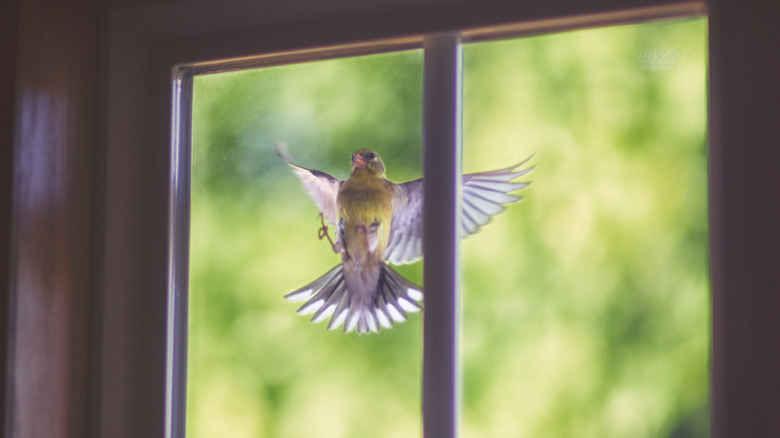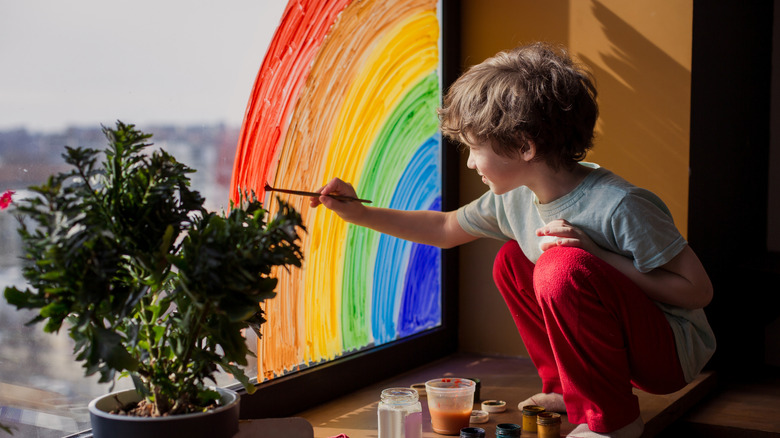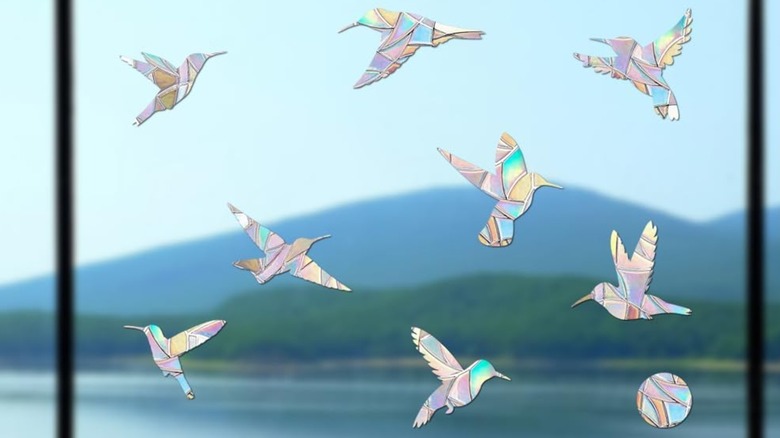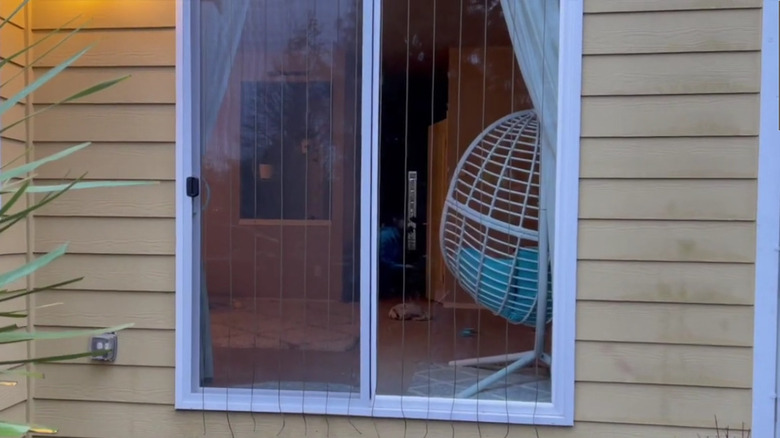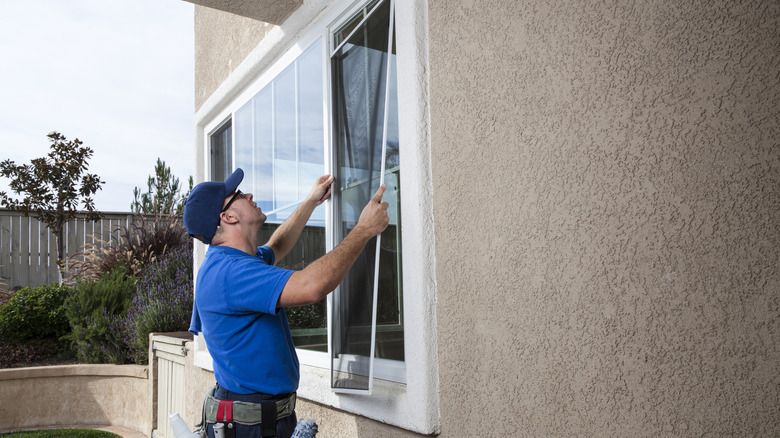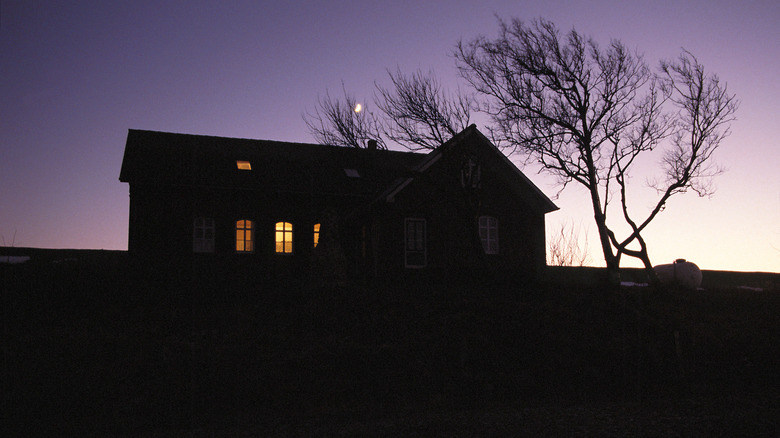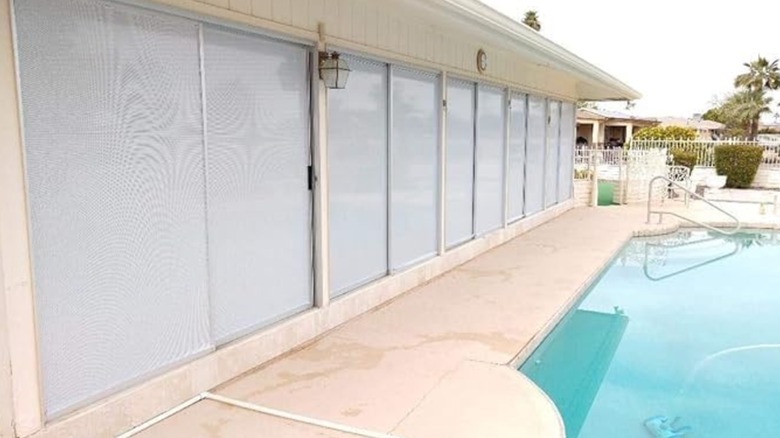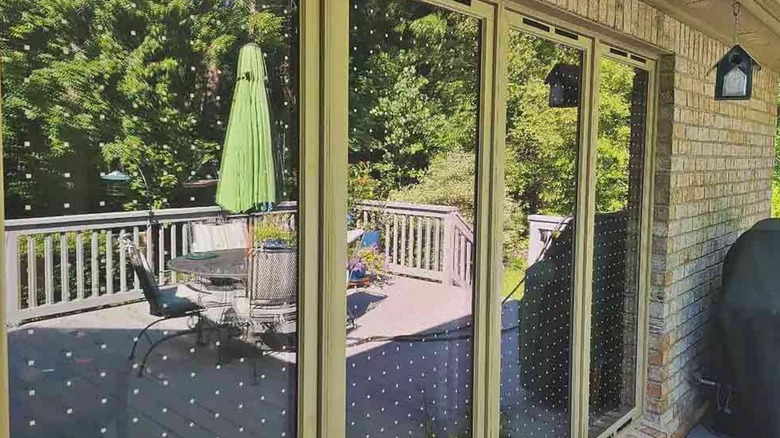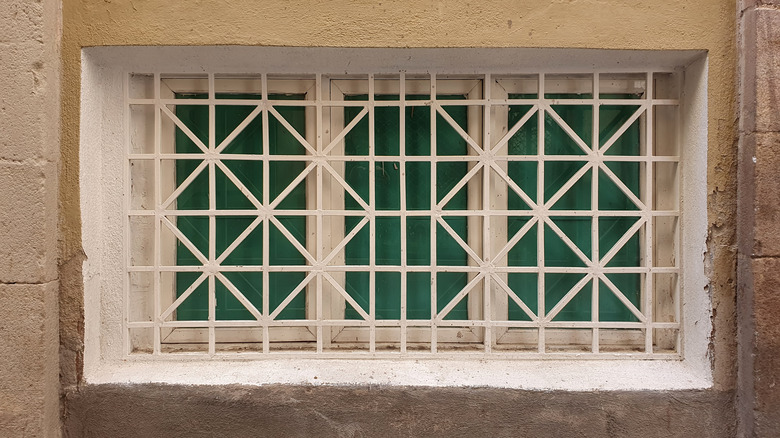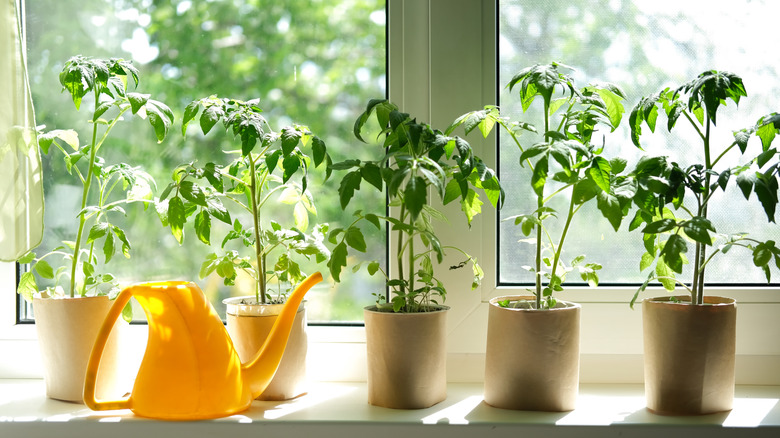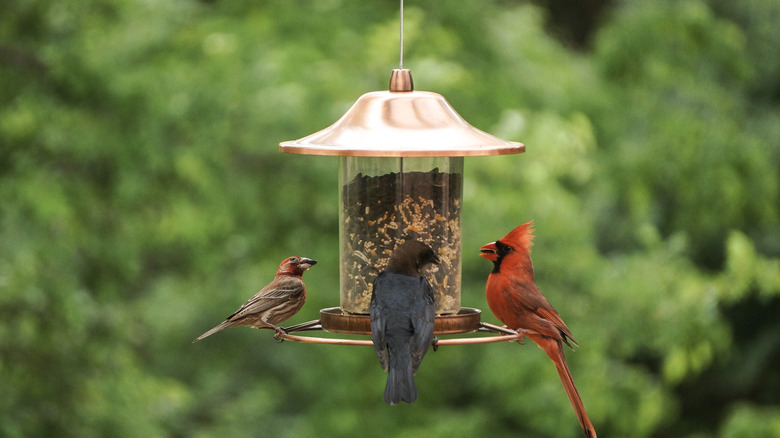Tips And Tricks To Keep Birds From Flying Into Your Windows
We may receive a commission on purchases made from links.
Watching a bird fly across your yard, only to see it slam into one of your windows, can be devastating. Because of how quickly they fly, crashing into a window can result in serious injury or even death. If this is regularly happening at your home, it can also be frustrating. Beyond the potential damage that they can cause (especially if they're larger birds), it can also leave you wondering why they're trying to fly through something that is (so obviously to us) a solid piece of glass.
The problem is that birds don't see glass the same way that we do. It doesn't look like a solid barrier that would prevent them from being able to access a space. From the outside, your windows often show reflections of trees or the sky, making them look like an inviting place for birds to fly towards. Light pollution can also confuse birds and decrease their visibility. Fortunately, you don't have to give up and accept that innocent birds will continue to die or sustain major injuries when they fly into your windows. Instead, there are a few tips and tricks that can help you prevent any more collisions.
Paint a pattern on the window with tempera paint so birds will realize they can't fly through it
The reason birds fly into glass windows is because they simply do not realize that they are there. They do not see them as an obstruction and believe that the reflection of the sky, trees, or other plants in the glass is actually something waiting for them to visit on the other side. So, to help prevent birds from injuring or killing themselves, you should ensure that they identify the windows as the barrier that they really are. One way to do this is to use tempera paint to add a pattern or design to the glass. With markings on the glass, birds will be less likely to see it as an open path they can fly through.
There are several things to consider before you pick up any type of paint and start decorating. First, the type and color of the paint matter. Choose a high-contrast color, such as white, to ensure that the birds are able to see it clearly. Actual paint is also a better option than trying to use something like ultraviolet markers. The ink of the latter will fade quickly, requiring much more frequent applications for continued effectiveness. This is why tempera paint is a top choice — it's very durable, and yet still can be removed easily with a sponge or cloth, and it's also non-toxic. The Handy Art Little Masters Washable Tempera Paint is one option you could try.
The design you paint on the windows is also critical in determining how effective it will be at protecting the birds. Grids, stencils, or your own artistic creations can all work as long as you do not leave too much space between any two sections of the design. There should be no more than 2 inches of space between any painted areas. Otherwise, the birds may only see what you've painted as something they need to avoid as they try attempt to fly through one of the gaps in the design.
Place decals on the outside of the windows
Decals are another option you can try to make your windows more visible to birds. Anti-collision decals — such as the Outus Window Strike Prevention Stickers Decals or EACILLES Static Window Clings Anti Collision Window Decals — are easy to apply. Their shape, design, and reflective qualities will alert birds that there is something blocking their way and that they should stop or turn away from the glass.
However, if not used correctly, decals will be ineffective, and you may still find that birds are colliding with your windows. First, you may have heard that placing one decal that shows the silhouette of a common predator, such as an owl or larger bird, can be effective. Unfortunately, this isn't the case, and relying on this method will not be effective. Next, proper spacingis imperative. If the decals are spread out too much, the birds will simply try to fly between the objects. To make sure they see the decals as a barrier, you must ensure that there is no more than 2 inches of space between each sticker.
Try zen curtains to deter birds from trying to fly into the windows
"Zen curtains," which are more formally known as Acopian BirdSavers, may also help birds perceive your windows as the barrier that they really are. Unlike curtains made from solid fabric, they are made by hanging several vertical cords outside the windows. The closely-spaced cords prevent birds from wanting to fly through the window, but don't obstruct the view of the outdoors for those inside the home.
Zen curtains are relatively easy to make and hang yourself using paracord rope that is about ⅛-inch thick, such as this Paracord Rope from HOKINETY. Before you start cutting or tying the paracord together to make the curtains, it is important to soak it in warm water. Otherwise, when it is exposed to moisture outside, it may shrink and not properly fill the window anymore. After the rope is dried, cut a base rope that is slightly wider than the window you wish to cover. Then, cut several pieces of rope that are as long as the window. The exact number of rope pieces you'll need will vary based on the width of the window, but be sure to cut enough that you can space them no more than 4 inches apart. Tie each of these ropes to the base rope and hang the whole thing above the window outside.
Install full-length screens or netting on the outside of the windows
Reflections in the windows are one of the main reasons that birds try to fly through them — they think there is something appealing on the other side. Therefore, reducing these reflections can help prevent birds from this potential disaster. One way to do this is by installing screens or netting on the exterior of the window. These options will help reduce reflections, while also creating a more visible barrier to alert birds to the hazard.
While standard window screens can decrease reflections, there are a few things to consider. First, if the screen doesn't span the entire length of the window (many windows only have a screen on the lower half), then it won't be fully effective. Birds could still crash into the upper half of the window. Second, if the screen is practically right up against the window (as many insect screens are), or are not fully taut, birds could still sustain an injury if they fly into it.
Instead, consider installing some mesh netting near your windows. Position the netting so it hovers a few inches away from the glass, and remove any slack so that if birds do fly into it, they will bounce back off instead of hitting the glass. You can do so by getting a suction cup screen, such as the ZXCVBNAS Suction Cup Window Shade.
Turn off the lights at night or close the blinds
While birds often collide with windows during the day, they may also crash into them when it is dark outside. Though daytime crashes are typically the result of the bird seeing a reflection of the sky or plants, the cause of nighttime collisions is related to your home's lighting. The light can change their planned flight path by attracting them, potentially sending them directly into one of your windows.
To help protect the birds from this threat, turn off outdoor lights at night when possible. If you need to leave lights on outside for safety or visibility reasons, consider installing fixtures that face downward, such as these Ken & Ricky Outside Wall Light Fixtures. To make sure that the light inside your house doesn't threaten the birds, you should also close the curtains or blinds in your house. These measures can help year round, but they will be even more important to implement during the spring and fall when birds are migrating and there may be more flying around your property.
Try window film for increased privacy and bird safety
Adding window film to the outside of your windows can help ensure birds don't view them as an open space through which to fly. It offers additional benefits as well. Window film can increase privacy and even potentially lower your energy costs during the summer by reducing how much sunlight comes in through the windows.
There are different types of window film to consider. The best choice for your home will vary based on your preferences and needs. One option to consider is one-way transparent film. CollidEscape White Bird Film, and similar products, make the windows look like they are a solid white color on the outside, preventing birds from trying to fly through them. However, because of the perforations in the film, light is still able to enter the home, and you will still be able to enjoy an unobstructed view outside.
If you want something that will be more visually appealing from the outside of the house, there are also decorative options to choose from. For example, SOLYX offers this bird safety film featuring a pattern of different types of birds. You could even repurpose the extra window film to give your mirrored closet doors a chic upgrade indoors.
Place dot decals on the windows
While effective, some methods that are designed to keep birds from flying into your windows can disrupt your view of the outdoors. If you're looking for something that won't hinder your view, consider creating a grid of white dots. After a few seconds, your eyes will adjust to the presence of the dots, allowing you to look outside as if they weren't even there. However, these small white dots will offer the benefit of keeping the birds from flying through your windows, as they'll notice them and stop or turn to fly away from the glass.
As with other deterrents, placement is critical. There should be no more than 2 inches of space between each dot to prevent the birds from trying to simply fly between them. You can purchase rolls of Feather Friendly Window Collision Tape, which makes it easy to lay out the grid of dots to deter the birds from hitting the glass. Alternatively, you could consider making a grid pattern with these Tiz Tlloz Dots Window Clings.
Add window grills for both security and bird deterrence
If you're looking for something decorative and more permanent, consider adding window grills. Also called muntins, these grids can be made from aluminum, wood, or vinyl, and are available in different colors and patterns. Placing one of these grills in front of your window will do more than increase your home's security — they can also serve as a physical barrier the birds will be able to identify much more easily.
When choosing a window grill, it is critical to pay close attention to the design. Many products on the market offer a wide grid-like design. If there are any gaps that are more than 2 inches wide, the grill won't effectively deter birds from flying into the window. To avoid this problem, you'll want to look for a grill with a more intricate design that eliminates the presence of gaps.
When replacing windows, opt for bird-safe fritted glass
If you've already considered the costs of window replacement and are ready to move forward with the project, now is the ideal time to choose bird-safe options. With one of these choices, you won't need to hang decals, window film, or take other measures to modify the windows so that the birds won't crash into them.
One type of bird-safe window to consider is called fritted glass. These windows have opaque glass dots on the exterior. The dots are close enough to act as a deterrent for the birds, but do not impede being able to see out the window from the inside of the house. You could also consider purchasing UV-reflective windows. In addition to keeping your heating and cooling costs down, these options will also help protect birds. While people can see right through the reflective glass, birds cannot.
Move indoor plants away from the windows
If you have indoor plants near your windows, you may inadvertently be encouraging birds to try to fly through the glass. Birds are attracted to plants and flowers — particularly if they feel threatened by the presence of a predator — so they may crash into the windows trying to get to your indoor garden.
Consider moving your plants away from your window sills, particularly if you don't plan on taking other steps to ensure that the birds are able to see the glass, such as adding decals or paint. Of course, you'll want to be purposeful about where you position them to ensure that their sunlight needs are still met. Perhaps replace some of your houseplants with species with lower sunlight needs, such as snake plants.
Reposition bird feeders and bird baths for an extra layer of protection
Even when you make modifications to the glass to help birds perceive there is a barrier, it doesn't fully eliminate the chances of them crashing into your windows. To further minimize the odds, consider repositioning your bird feeders and bird baths. If these are far away from your windows, once the birds finish eating or splashing around, they'll have lots of time to build up speed if they fly towards the windows. As you can imagine, the faster they are flying, the more dangerous it will be to crash into the glass.
Instead, the best place to hang a bird feeder will be one that is relatively close to your windows, but still far enough away that the birds won't hit the window if they slightly overshoot the feeder). Aiming for a distance of around 3 feet from the window is ideal. It's a bit of a balancing act that you may need to play around with, depending on your home's specific needs and setup.
